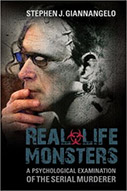Real-Life Monsters: A Psychological Examination of the Serial Murderer
 Author: Stephen J. Giannangelo
Author: Stephen J. Giannangelo
Publisher: Santa Barbara, CA: Praeger, 2012. 193p.
Reviewer: Jaclyn Schildkraut | July 2013
Serial killers have both fascinated and repulsed people throughout history. They walk among us, they look, in most cases, no different from the rest of us, yet within those bodies, and in particular their minds, something very different than what most people experience takes place and drives the serial murderer to kill, over and over, not stopping until he, or sometimes she, is caught.
In Real-Life Monsters: A Psychological Examination of the Serial Murderer, author Stephen J. Giannangelo, himself a special agent supervisor for the Bureau of Criminal Investigation of the Illinois Department of Revenue and adjunct instructor at Illinois State University, takes a two part look at serial murderers. Most of the prior writing on this topic has concerned itself with repeating and rehashing long-standing theories about the serial murderer: who he is, who his victims are, how they are chosen, all essentially efforts to dissect and explain the heinous actions of this group of people.
In the first part of this new study, the author provides a refreshingly new and in-depth look at the development of a serial murderer, starting with the very basic question: Who exactly IS a serial killer? Most people use that term interchangeably with the terms “mass murderer” and “spree killer,” but in reality, the three labels define different subsets of people motivated by very different dynamics. This book’s sole focus is on the identification and characterization of the person who kills simply for the joy of killing.
The author delves into the development of a serial murderer by examining the traits that serial killers seem to share: among these are personality disorders, such as antisocial personality disorder (APD), psychopathic and borderline personalities, doubling (comparatively new term where the self divides into two functioning whole parts), and narcissistic personality disorder, among others. He examines the role of the biology of an individual and how it can lead to and impact a person’s violent behavior, and also looks further into how environment, background, and personality all play a part in shaping the future serial killer.
In the second part of the book, Mr. Giannangelo provides eight detailed case studies of individual serial killers, many of whose names are familiar: Andrei Chikatilo, Arthur Shawcross, Jeffrey Dahmer, Edmund Kemper, Anthony Sowell, Aileen Wuornos (the sole woman among the group), Dennis Rader (the BTK Killer), and Rodney Alcala, who actually was a chosen winner on television’s The Dating Game, although the woman who selected him from among the three eligible bachelors decided, in the end, not to go out with him, possibly a life-saving decision on her part. After introducing the reader to the specific killer, each study is broken down similarly into the categories of Physiological Factors, Environmental Trauma, Early Antisocial Behavior and Prior Crimes, Problematic Social Deviance, Personality Disorders or Dissociative Episodes, Serial Murder, and Other Observations — each a detailed mini-study of the topic as it related to that killer.
The final two sections of the book are fascinating reading as well. In the “Conversation with a Monster?” chapter, Giannangelo discusses, in depth, conversations he had in person and by letter with a convicted serial killer inmate on his state’s death row who had responded to the author’s request to a number of imprisoned serial killers, both well known and obscure, seeking someone with whom he could open an ongoing dialogue about the topic. The results of those exchanges, shared by the author in this book, are enlightening and as absorbing as they are abhorrent and repulsive — a living example of “man’s inhumanity to man.”
Giannangelo concludes the book with a discussion of issues for future study, changes he’d like to see made in methodology for future studies, and additional case testing. The final chapter also contains a glossary of the psychological terms frequently used in the book, and a section of case briefs which detail a long list of serial killers and their deeds.
Jaclyn Schildkraut is a Ph.D. student at Texas State University


